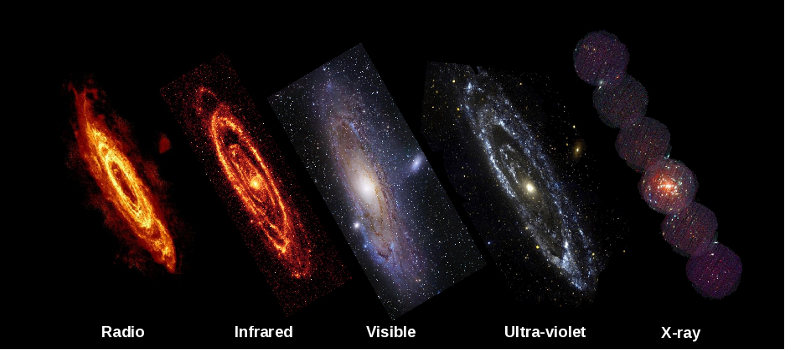Section 3.1.2: Do all galaxies look the same?
Section 4.1.2: Do all galaxies look the same?
The simple answer is no! Galaxies don’t all look the same. We find that they come in two main shapes - spiral and elliptical. A third category - irregular - covers galaxies that don’t fit neatly into the spiral or elliptical classification. As you can see in the picture below, spiral galaxies have arms that wind out from a bulge in the centre. On the other hand, elliptical galaxies look smooth with little or no features. Irregular galaxies are not so easily characterised, as this category contains everything from tiny (in astronomical terms!) dwarf galaxies, to huge distorted galaxies.




Examples of the different galaxy morphologies. Clockwise from top left: spiral galaxy NGC 3982; elliptical galaxy NGC 1132; irregular (interacting) galaxies NGC 4038/4039; irregular galaxy NGC 1427A. (credit: NASA, ESA, and the Hubble Heritage Team)
Astronomers classify spiral and elliptical galaxies into further sub-categories. Elliptical galaxies are classified based on how stretched out they look, ranging from E0 (circular) to E7 (cigar shaped). Examples of different elliptical galaxies are shown below:

Left to right: NGC 1379, 3193, 5322, 1426, and 720 (credit: Buta, R "Galaxy Morphology" astro-ph/1102.0550)
The classification of spiral galaxies is mainly based on how tightly-wound their arms are, but also the size of the central bulge. Spiral galaxy classifications range from Sa (tightly-wound, large bulge) to Sc (loosely-wound, small bulge). Spiral galaxies are further split into two types, based on whether there is a “bar” running through the centre. Barred spiral galaxies are denoted SBa to SBc. Examples of different spiral galaxies are shown below.

Top row: unbarred spiral galaxies, left to right NGC 4378, 7042, 628. Bottom row: barred spiral galaxies, left to right NGC 4314, 1300, 3513 (credit: Buta, R "Galaxy Morphology" astro-ph/1102.0550)
Classifying spiral galaxies can be harder than classifying elliptical galaxies because your view of a spiral galaxy depends on the angle it is at in the sky or its orientation. When a spiral galaxy is “face-on”, it is easy to see the arm structure, however if it is “edge-on” you cannot see the arms at all. This is illustrated below:


Left: Face on spiral galaxy NGC 3982 (credit: NASA, ESA, and the Hubble Heritage Team (STScI/AURA). Right: Edge on spiral galaxy NGC 5866 (credit: NASA, ESA, and The Hubble Heritage Team (STScI/AURA).
The shape of a galaxy is important to astronomers as it provides an insight into the galaxy’s history - how it formed and evolved over time. However, there are far too many galaxies out there for professional astronomers to classify, and this is where you can help. The Galaxy Zoo project asks members of the public to answer simple questions about the shapes of galaxies, classifying them in the process. These classifications are then used by the science team to do their research and so far over 40 peer-reviewed research papers have been published based on Galaxy Zoo results.
ACTIVITY: Go to Galaxy Zoo and classify some galaxies!

